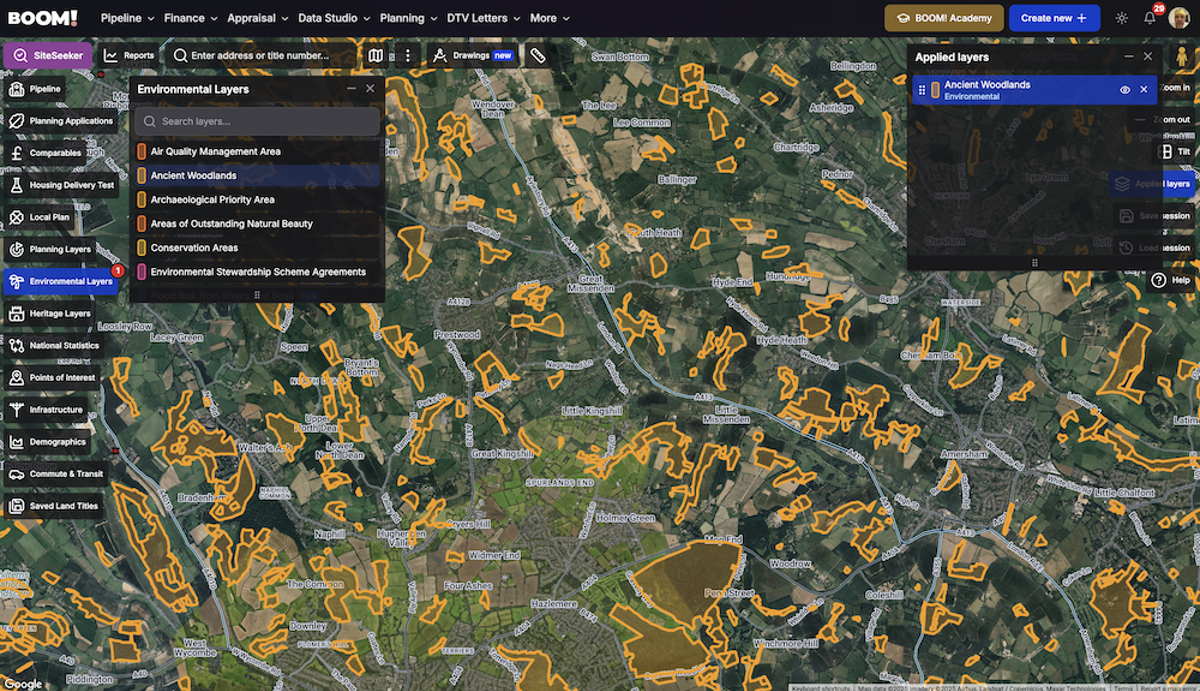How to Find Profitable Development Sites Without Falling Into the Ancient Woodland Trap







Imagine you spot a seemingly perfect plot of land. Great location, decent price – a new developer’s dream. Then two little words appear on the site report that send your plans crashing down: “ancient woodland.” If you’ve never heard that term, you’re not alone – but ignoring it could cost you thousands and months of wasted effort. In the UK, ancient woodlands are the hidden deal-breaker that every ambitious property developer must understand. In this guide, we’ll demystify ancient woodlands and show you how to turn this potential project-killer into a savvy advantage. Let’s dive in.
An ancient woodland in the UK, with centuries-old trees and rich undergrowth. Such sites are ecologically precious – and can be planning minefields for unwary developers.
What Are Ancient Woodlands (and Why All the Fuss)?
“Ancient woodland” refers to a forested area that’s been continuously wooded for centuries – in England, Wales, and N. Ireland since at least 1600 AD (and since 1750 in Scotland). In plain English: these woods have been around longer than the United States, and they’re brimming with rare wildlife and irreplaceable ecosystems. Ancient woodlands cover only about 2.5% of UK land, and sadly over 70% of those ancient woods have already been lost over time. In short, they’re incredibly scarce and valuable. No wonder they inspire fierce protection!
For new developers, it’s crucial to grasp that ancient woodlands aren’t just pretty groves of old trees – they’re legally and culturally untouchable in many cases. The UK’s National Planning Policy Framework (NPPF) gives these sites near-sacred status. In fact, planning authorities must refuse development proposals that would result in the loss or deterioration of an ancient woodland except in “wholly exceptional” circumstances. (And by exceptional, we’re talking national infrastructure or truly one-in-a-million reasons – your housing scheme won’t qualify.) These woods are considered “irreplaceable” habitats, so you can’t simply offset their destruction by planting new trees elsewhere.
Bottom line: If your potential site contains an ancient woodland (or even borders one), any plan to clear or build on it is basically a non-starter. Local councils, environmental groups, and the public will line up to oppose you. Just ask the developers who tried to place 150 homes next to an ancient wood in Derby – that plan drew almost 1,500 objections and was roundly refused by the council amid uproar about protecting the “irreplaceable” forest. Or consider a recent case in East Sussex: the council rejected a leisure development that threatened an ancient woodland, and when an inspector later approved it, the council took the fight to the High Court to defend those trees. In 2025, over 1,200 ancient woods across the UK are under threat from development and other pressures, and communities are increasingly vigilant. You do not want to be the rookie developer caught on the wrong side of this issue.
The Ancient Woodland “Trap” – How It Can Derail Your Project
Why call it a trap? Because to the unwary deal-finder, a site with an ancient woodland can look perfectly buildable at first glance – only to spring nasty surprises during planning. Here are the key pitfalls to watch out for:
You can’t remove ancient woodland: Obviously, cutting down an ancient woodland for timber or clearing it for houses is off-limits for a small developer. It’s almost guaranteed to fail planning (unless you fancy a national scandal). Even “thinning out” an ancient wood or nibbling at its edges is viewed as harm.
Buffers eat into your land: Even building near an ancient woodland triggers strict rules. Government guidance says any development should leave an undeveloped buffer zone of at least 15 metres from the woodland boundary. Often an even larger gap is required if there could be indirect impacts (noise, light, pollution) reaching the trees. And this buffer isn’t just empty talk – you typically cannot put anything in it, not even gardens or sheds for new homes. That means if a portion of your plot falls within 15m of the ancient wood, you have to treat that part as untouchable green space. Your actual buildable area shrinks fast.
Extra costs and delays: Building next to ancient woodland often means you’ll need expensive ecological surveys and arboricultural reports to prove you won’t harm the habitat. Planners may demand detailed mitigation plans (like special fencing, lighting limits, etc.) which take time and money. If there are ancient or veteran trees on site (individual old trees with similar protection), they each need buffers and careful treatment too. All this can slow your project to a crawl.
Heightened scrutiny: Proposing anything even remotely impacting an ancient wood puts a spotlight on your scheme. Local wildlife groups, residents, and bodies like the Woodland Trust or Natural England will scrutinise it. Objections can pile up, and officers will have to be extra sure your plan is benign. It raises the bar for approval significantly – not ideal when you’re already navigating the usual planning maze.
In short, an ancient woodland on or near your site can turn what looked like a profitable development into a poisoned chalice. But here’s the good news: if you know how to spot these constraints early, you can avoid falling in the trap entirely.
Smart Strategies to Avoid (or Embrace) Ancient Woodland Constraints
1. Do Your Homework Upfront: Before you even bid on or option a piece of land, check for ancient woodlands. This isn’t hard to do – BOOM! has integrated this data through Natural England. Just enable the layer, zoom in on your prospective site and see if any part is shaded as ancient woodland. If it is, a big red warning light should start flashing in your mind. If you’re using BOOM! for site sourcing you can simply remove all sites affected by ancient woodlands by including a hard constraint as part of your strategy. Seasoned developers know to rule these out unless they have a very clever plan.
2. If It’s There, Preserve It: If you discover an ancient woodland on your target site but still believe in the project, pivot your approach. Do not plan to touch or build on the woodland – instead, design around it. Treat the trees as a central feature to be treasured. You’ll still need that 15+ metre buffer of open space, so incorporate that into your layout as a nature reserve or amenity area for the development. In other words, turn the “dead” space into a selling point: walking trails, benches overlooking the woods, educational signboards about the ancient forest for the community. By showing you will protect and even enhance the woodland (rather than harm it), you might win support for building elsewhere on the site. Always get expert ecologists involved early to guide what is and isn’t possible. And be prepared for a slightly lower site density – you can’t cram houses right up to the trees.
3. Leverage the Upside: Here’s something many newbies miss – a well-preserved ancient woodland can actually boost your development’s appeal (and value) if handled right. People love living near beautiful, mature woods. In fact, homes within 50 metres of woodland in the UK sell for about 6% higher prices on average, with premiums up to 15% in certain regions. Think about it: “Woodland views” and access to nature are huge draws, especially post-pandemic when buyers crave green space. So rather than seeing an ancient woodland as a nuisance, see it as a unique amenity. Market your site as offering back-door access to a timeless forest that will never be cut down (because it’s protected). That’s a bit of magic no new planted landscaping can replicate. The key is you must commit to safeguarding that woodland – both because the law requires it, and because its presence is a selling point. Done right, you create a win-win: wildlife gets a refuge, homeowners get scenery and recreation, and you get a premium on your units.
4. Know When to Walk Away: As empowering as knowledge is, sometimes the best move is to simply pass on a site with ancient woodland. If the woodland covers a large chunk of the land, or sits exactly where your access or infrastructure would need to go, you might be trying to fit a square peg in a round hole. There are plenty of other opportunities out there that won’t mire you in controversy and impossible design gymnastics. Avoid sunk-cost fallacy – better to lose a deal now than spend years fighting a losing battle with planning committees and angry neighbors later. Use that time to find a site where the constraints are easier to manage. Remember, waiting costs less than a failed project.

Takeaway: Turn “Uh-Oh” into Edge
By now, you’ve gone from maybe never hearing of ancient woodlands to knowing why they command such respect – and how that affects your development hustle. The curious newbie in you should feel satisfied (who knew only 2.5% of land is ancient woodland? ), and the savvy dealmaker in you should feel armed and ready. Here’s the kicker: most amateur developers won’t bother to learn this stuff. They’ll charge ahead, oblivious, until an ancient oak grove shatters their plans. Not you. You’ve got insider knowledge now.
So, the next time you’re evaluating a juicy plot, immediately check for those magic words. If you see an ancient woodland noted, you won’t run scared – you’ll know exactly what to do. Either steer clear, or adjust and turn that natural wonder to your advantage. Fast wins in property development aren’t about cutting corners; they’re about cutting out mistakes. And overlooking an ancient woodland is a big mistake. The developers who prosper in 2025 are the ones who source sites smarter, with eyes wide open to all the hidden traps and opportunities.
Ancient woodlands can be a deal-breaker, but now you know how to not only avoid the trap, but springboard from it. Do your due diligence, respect the land, and you’ll keep your projects both profitable and principled. There’s real power (and profit) in being the developer who gets it. Now go out there and find that next great site – just make sure there isn’t a 500-year-old oak standing in the way!
To better understand how you can leverage ancient woodlands sign up for a 7 day FREE trial or book a call with us and let us show you.